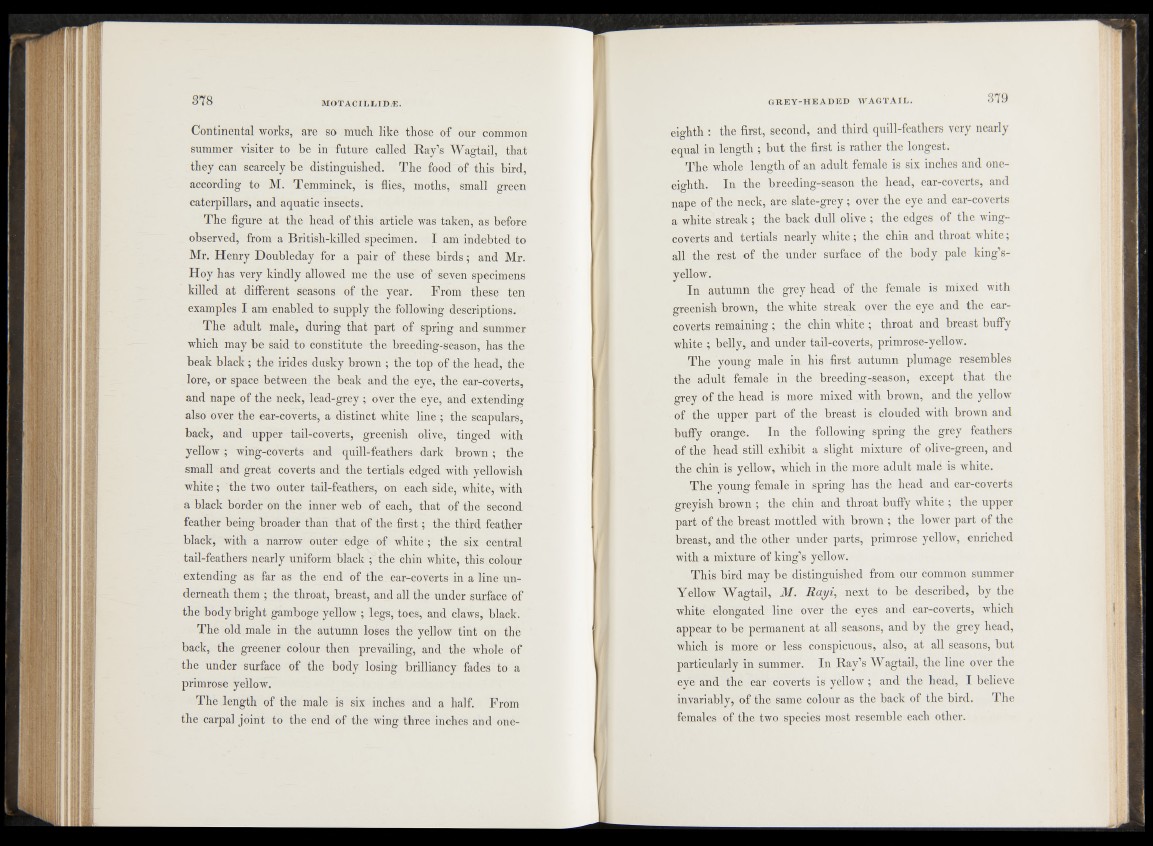
Continental works, are so mucli like those of our common
summer visiter to be in future called Ray’s Wagtail, that
they can scarcely be distinguished. The food of this bird,
according to M. Temminck, is flies, moths, small green
caterpillars, and aquatic insects.
The fi gure at the head of this article was taken, as before
observed, from a British-killed specimen. I am indebted to
Mr. Henry Doubleday for a pair of these birds; and Mr.
Hoy has very kindly allowed me the use of seven specimens
killed at different seasons of the year. From these ten
examples I am enabled to supply the following descriptions.
The adult male, during that part of spring and summer
which may be said to constitute the breeding-season, has the
beak black; the irides dusky brown ; the top of the head, the
lore, or space between the beak and the eye, the ear-coverts,
and nape of the neck, lead-grey; over the eye, and extending
also over the ear-coverts, a distinct white line ; the scapulars,
back, and upper tail-coverts, greenish olive, tinged with
yellow; wing-coverts and quill-feathers dark brown ; the
small and great coverts and the tertials edged with yellowish
white; the two outer tail-feathers, on each side, white, with
a black border on the inner web of each, that of the second
feather being broader than that of the first; the third feather
black, with a narrow outer edge of white ; the six central
tail-feathers nearly uniform black ; the chin white, this colour
extending as far as the end of the ear-coverts in a line underneath
them ; the throat, breast, and all the under surface of
the body bright gamboge yellow ; legs, toes, and claws, black.
The old male in the autumn loses the yellow tint on the
back, the greener colour then prevailing, and the whole of
the under surface of the body losing brilliancy fades to a
primrose yellow.
The length of the male is six inches and a half. From
the carpal joint to the end of the wing three inches and oneeighth
: the first, second, and third quill-feathers very nearly
equal in length ; but the first is rather the longest.
The whole length of an adult female is six inches and one-
eighth. In the breeding-season the head, ear-coverts, and
nape of the neck, are slate-grey; over the eye and ear-coverts
a white streak ; the back dull olive ; the edges of the wing-
coverts and tertials nearly white; the chin and throat white;
all the rest of the under surface of the body pale king’s-
yellow.
In autumn the grey head of the female is mixed with
greenish brown, the white streak over the eye and the ear-
coverts remaining; the chin white ; throat and breast buffy
white ; belly, and under tail-coverts, primrose-yellow.
The young male in his first autumn plumage resembles
the adult female in the breeding-season, except that the
grey of the head is more mixed with brown, and the yellow
of the upper part of the breast is clouded with brown and
buffy orange. In the following spring the grey feathers
of the head still exhibit a slight mixture of olive-green, and
the chin is yellow, which in the more adult male is white.
The young female in spring has the head and ear-coverts
greyish brown ; the chin and throat buffy white ; the upper
part of the breast mottled with brown ; the lower part of the
breast, and the other under parts, primrose yellow, enriched
with a mixture of king’s yellow.
This bird may be distinguished from our common summer
Yellow Wagtail, M. Rayi, next to be described, by the
white elongated line over the eyes and ear-coverts, which
appear to be permanent at all seasons, and by the grey head,
which is more or less conspicuous, also, at all seasons, but
particularly in summer. In Ray’s Wagtail, the line over the
eye and the ear coverts is yellow; and the head, I believe
invariably, of the same colour as the back of the bird. The
females of the two species most resemble each other.